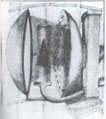Lighthouse Lamps and Lenses
Early U.S. lights were limited by the technology of the time. The lighting apparatus commonly used consisted of shallow container of whale oil, in which floated several lighted, solid, wicks. This was known as a "spider lamp". Its range of visibility was quite poor and it emitted quite a bit of smoke and fumes.
The Lewis Parabolic Reflector

The first major step forward is associated with an ex transatlantic ships captain from Boston named Winslow Lewis. The U.S. trade embargo of 1807 forced Lewis to change careers. A man of great ambition, he saw the opportunity to improve the infant U.S. lighthouse system he had had contact with as a mariner. Lewis is viewed by history in both favorable and unfavorable lights. He was one of the main characters in developing the early lighthouse system later taken over by the 5th Auditor, Stephen Pleasonton, and built several lighthouses himself. However, he is also remembered for his parabolic reflector lighting system. This was a poorly constructed copy of a system developed in Switzerland by Jean Robert Argand, which Lewis modified slightly and patented as his own. It consisted of a wick or, more often, series of wicks, each fitted with parabolic reflectors and a convex lens. In 1812 the Secretary of Treasury contracted with Lewis to outfit all existing U.S lighthouses as well as those built in next 2 years with his lighting apparatus. Lewis later developed a strong relationship with Pleasonton and his lighting system was used in U.S. lighthouses for over 40 years. While it was a great improvement over earlier primitive lamps, it was far inferior to the later-developed Fresnel lens. Its continued use in U.S. Lighthouses including installation in new lanterns, long after other countries adopted the Fresnel lens was gross negligence.
The Fresnel Lens


The effectiveness of lighthouse beacons took a giant leap forward in 1821 when a young French engineer named Augustin-Jean Fresnel developed a new magnifying lens comprised of a series of crystal prisms. The prisms focus the light source into a powerful beam that was many times more visible than that produced by earlier lens designs. Use of the Fresnel lens quickly spread through Europe, but their adoption in the U.S. and on the Chesapeake Bay was delayed by the inadequacies of the 5th Auditor's administration. It was not until the system overhaul of 1852 that Fresnel lenses began appearing in U.S. Lighthouses
Fresnel lenses are divided into "orders" - one through six. A first order Fresnel lens is the biggest and the type used by large ocean lighthouses. They stand approximately 8 feet tall, with an inside diameter of 6 feet, can weigh over 5 tons, and may have a range of 18 to 20 miles. A sixth order lens is reasonably small - about 17 inches tall with an inside diameter of 11 1/4". It can weigh up to 200 pounds and has a range of 1 to 3 miles. Most of the Chesapeake Bay lighthouses constructed in the mid 1800s were originally fitted with fifth order Fresnel lenses. In the later part of the 1800s these were usually upgraded to fourth order lenses (which stand about 2 1/2 feet tall and have an inside diameter of about 20").
In addition to being a precision tool, each lens is also somewhat of a work of art. They are made up of a series precision hand-crafted crystal prisms which are linked together. While their material and labor value is high, when historic and antique factors are also considered, they are somewhat priceless. Fresnel lenses are still used today in industrial and stage lighting as well as in lighthouses. The underlying technology is used in small lanterns and the running lights on boats. Understandably, the materials have evolved from hand crafted crystal to acrylic plastics, just as the light sources have evolved from oil fueled wicks and mantles to high tech electric bulbs.